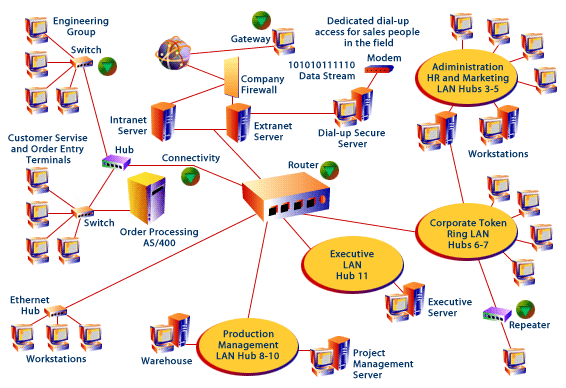| Lesson 5 | Connectivity hardware |
| Objective | Describe Some Examples of Connectivity Devices. |
Some Examples of Connectivity Devices
Connectivity hardware allows a program or device to link with other programs and devices.
Connectivity refers to a program or device's ability to link with other programs and devices. For example, a program that can import data from a wide variety of other programs and can export data in many different formats is said to have good connectivity. On the other hand, computers that have difficulty linking into a network (many laptop computers, for example) have poor connectivity.
Organizations connect to the Internet to provide Internet access to users on the private network and to allow users on the Internet access to private network resources. The Internet connectivity solution must prevent unauthorized users from accessing private network resources.
The following MouseOver illustrates the various types of connectivity hardware and their respective functions:
Connectivity refers to a program or device's ability to link with other programs and devices. For example, a program that can import data from a wide variety of other programs and can export data in many different formats is said to have good connectivity. On the other hand, computers that have difficulty linking into a network (many laptop computers, for example) have poor connectivity.
Organizations connect to the Internet to provide Internet access to users on the private network and to allow users on the Internet access to private network resources. The Internet connectivity solution must prevent unauthorized users from accessing private network resources.
The following MouseOver illustrates the various types of connectivity hardware and their respective functions:

- external sites,
- customers,
- suppliers and
- trading partners
Middleware
Also required is the talking between client and server over heterogeneous networks, systems architectures, databases, and other operating environment. All this is facilitated by the middleware technologies that offer functions to seamlessly integrate various applications with information instantly to make it accessible across diverse architectures, protocols, and networks.
Automation of back-end and front-end operations of business is also effected by the middleware.
Middleware binds discrete applications, such as Web-based applications and older mainframe-based systems, to allow companies to hook up with latest systems and developments that drive new applications .
Hardware Connections
In the next lesson, you will learn about common problems related to connectivity hardware.
In the next lesson, you will learn about common problems related to connectivity hardware.